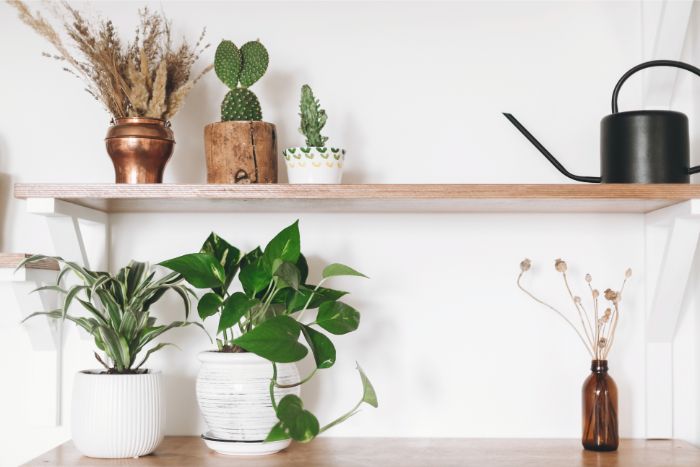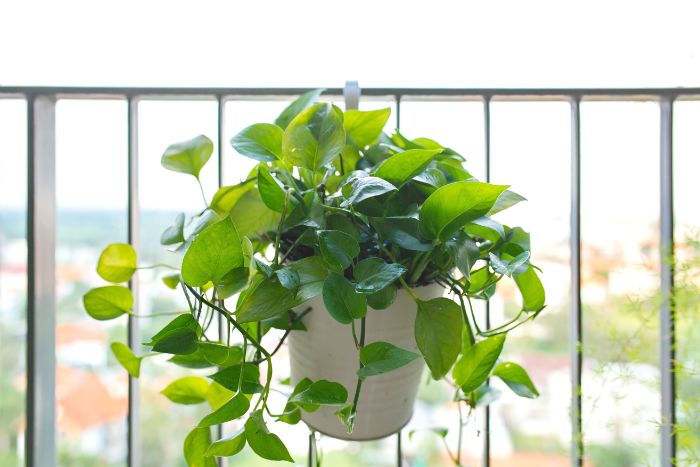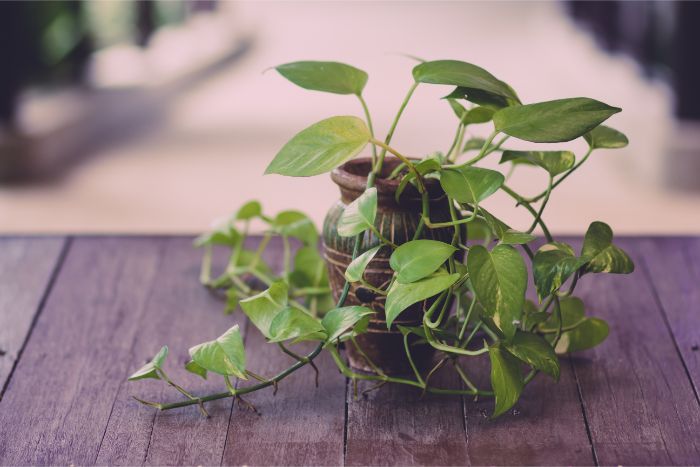Pothos (Devil’s Ivy) is an undemanding and easy to care for houseplant that usually thrives in most conditions. However, if your Pothos starts getting curled leaves, it can be a sign that the plant is not happy. This article will explain why your Pothos leaves are curling and how to prevent it.
Why are my Pothos leaves curling? In most instances, Pothos leaves curl for the following reasons:
- Underwatering.
- Overfeeding the Pothos with fertilizer.
- Temperature stress.
- Root rot from overwatering.
- Too much or too little light exposure.
- Disease/insect infestation.
If your Pothos is starting to get curling leaves and other symptoms of distress, take some time to get to the bottom of it. Once you know the cause, you can fix the problem and your Pothos can thrive once more. Read on to learn more about the causes and solutions to leaf curl in Pothos plants.
6 Reasons Why Your Pothos Plant Leaves Are Curling
If you are trying to understand why your Pothos leaves are curling and want to know what course of action to take to revive the plant, consider the 6 following potential reasons behind the problem:

1. Underwatering Your Pothos Can Cause Curling Leaves
How much water you give your Pothos can have an impact on its long-term overall health. When a Pothos plant receives little to no water, the leaves will start to curl in an attempt to retain moisture.
Shortly after curling, the leaves will become limp and even wilt. If it’s just a case of underwatering and you manage to catch the problem early on (hopefully you spot the curling problem just as it starts to occur), the leaves should perk up quickly and return to normal after watering.
While Pothos plants like soil to dry out between watering, it also performs best when it receives a decent soil drenching on a regular basis. To ensure that your Pothos never suffers underwatering, note how long it typically takes for the soil to dry after watering and set yourself a schedule or reminders.
2. Overfeeding A Pothos Plant Can Cause Leaves To Curl
Overfeeding can be tricky to tell apart from other problems that can cause curling leaves. However, one tell-tale sign that curling may be caused from overfeeding is if the leaves are generally smaller than usual and have changed color (in most instances darker green or even yellowish) while at the same time show signs of curling downwards at the tips.
Most people overfeed their Pothos by using too much fertilizer or fertilizing the plant too often. In most cases, over fertilizing a house plant results in the build up of salts and nitrogen in the soil.
You don’t need to fertilize your Pothos more than once or twice a year. If you are over feeding your Pothos, there are other tell-tale signs you can look for, in addition to curling leaves. These include:
- Yellowing or browning leaves. (Read more about why Pothos get yellow leaves in my article here).
- The top surface of the soil may be white or crusty.
- The leaves of the plant will start dropping off.
- The roots can begin to rot.
If your plant’s leaves are curling from over feeding, you can remove the houseplant from its current soil and repot it in fresh soil. This is undoubtedly the best way to get rid of the excess nutrients affecting your plant.
Alternatively, you can flush the soil, which involves drenching the soil with water and letting it drain out. Repeat this several times to help the soil get rid of excess fertilizer.
3. Temperature Stress
If your Pothos is exposed to temperature stress (usually too much heat) the leaves may start to curl downwards at the edges. Pothos plants thrive at temperatures of 65 – 85 ºF (18-29 ºC). Temperatures outside this range increase stress to the plant and increase the chance of problems.
Keeping your Pothos indoors will help you to monitor and manage the temperature that the plant is exposed to. Where you position the plant in the home can also help. For instance, avoid direct sunlight, as the intense heat and light can cause leaf burn. Also, avoid placing your plant where it may be affected by hot or cold drafts.

4. Root Rot Can Cause Pothos Plant’s Leaves To Curl
Root rot is caused by overwatering or poor drainage, which leads to waterlogged soil. The roots cannot survive for prolonged periods in these conditions, and without functioning roots, the plant is in big trouble.
When the roots rot, water and nutrients cannot make their way up the plant and into the stems and leaves. Although there is plenty of water in the soil, the leaves become dehydrated and begin to curl while they desperately attempt to retain water.
If your Pothos has root rot in the early stages, you can most likely save it. Simply unpot the plant and investigate the roots. Healthy plant roots are white in color. Use scissors or a pruner to remove any brown sections as these are suffering root rot. Once you are done, wash your equipment and replant the Pothos in fresh, well-draining soil.
If you want to learn how to give your indoor plants the perfect amount of water, read my article about how often to water your houseplants.
5. Incorrect Light Exposure
A healthy Pothos plant will have broad, flat leaves that turn to face towards the source of light. If the leaves look like they are reaching or curling in the direction of the light source, you are most probably dealing with a case of too little exposure to sunlight/natural light. You can try to rectify the problem by placing the plant in a sunnier spot or a spot that gets more natural light over the course of the day.
If the leaves are drooping and curling away from the light (downwards), it could be getting too much light. Overexposure to sunlight can be just as damaging to the health of your plant. If you want to rectify the problem, you can move your plant to an area that doesn’t receive quite so much direct sunlight or that receives a little less sunlight over the course of the day.
6. Disease Or Insect Infestation
Insect infestation damage and disease can also cause a Pothos to develop curled leaves. Typically, pests or insects that suck the plant sap from the young leaves cause curling. If you notice any bugs or insects settling on your Pothos, remove them immediately.
You can wipe the plant down regularly with rubbing alcohol to deter insects from the plant (or to give the plant a fighting chance after you have removed insects from it).
You can also create your own environmentally friendly insecticide by mixing 1 teaspoon of dishwashing soap liquid in 1 liter of water. This solution can be lightly sprayed over the entire plant. This should get rid of existing insects as well as deter any future insects from making their home on your Pothos houseplant.
I’ve written an article that covers loads of great ways to get rid of houseplant bugs naturally. Read more here.
Last Word
As you can see, there are a number of reasons why your Pothos plant can get curled leaves. Before deciding how to rescue your houseplant, spend a bit of time investigating which of these problems the plant might be suffering.
The good news is that Pothos plants are quite hardy and generally recover quickly (and well) if treated promptly and correctly. If you want to know more about how to give your Pothos perfect growing conditions, read my article about how to grow Pothos plants faster.

